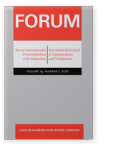Vol. 14:2 (2016) ► pp.239–254
Foreign language courses for translation undergraduates
Adapting to changes in translation directionality – A case study: English grammar for Arabic students
In most parts of the world the principle of translating into one’s native language is rarely observed. Translators find themselves working equally into a foreign language (L2), especially English. This shift in translation directionality needs to find its way to the translation classroom, but even before that, to the L2 courses that precede practical translation training. These courses, so far directed towards improving students’ ability to understand foreign language texts, have to take a new turn towards developing the increasingly required production competence. As the present study has shown, certain rules of English grammar constitute the stumbling block for Arabic undergraduates and generate a number of regularly occurring errors in their English texts. Grammar and other language courses, instead of following the content of standard textbooks, should be designed and delivered to serve the real needs of students and help them to develop the increasingly required L2 production competence.
Article outline
- Introduction and background
- Significance of the study
- Method and procedure
- Grammatical difficulties specific to Arabic undergraduates translating into English
- Are the difficulties adequately addressed in grammar courses?
- Findings and discussion
- Conclusion
-
References
